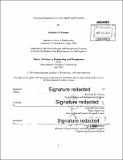A systems perspective on army health and discipline
Author(s)
Fosmoe, Kristofer D
DownloadFull printable version (13.15Mb)
Other Contributors
System Design and Management Program.
Advisor
Jayakanth Srinivasan.
Terms of use
Metadata
Show full item recordAbstract
Healthy and Disciplined Soldiers provide a unique competitive advantage to the United States Army that cannot be replaced by the acquisition of technological weapons systems. The United States Army system for managing health and discipline has historically been robust; however, the prolonged conflicts in Iraq and Afghanistan have highlighted the need to reexamine the system of health and discipline policies, its architecture, and the dynamic effects on junior leader behavior. This thesis provides an analysis of this system by exploring the dynamic relationship between leader development, health and discipline, and an emphasis on warfighting mission capabilities. The author demonstrates the tradeoffs between mission capabilities, and leader development of Soldier health and discipline through a mixed methods approach that combines quantitative analysis of the published Army literature and qualitative field interviews. This thesis analyzes the architecture of the Army Health Promotion system, highlighting risks to capability development if the system architecture is not consistently managed across installations. The author applies the object-process method to describing architectural models of policy systems and system dynamics causal loop diagrams to explain the evolution of the system during the post 9-11 war period. The author also uses quantitative article subject search to validate qualitative descriptions of the system behaviors. The author suggests that there is some risk in the Army failing to more effectively manage Soldier health and discipline due to failing to properly describe the intended architecture of the Army Health Promotion system, resulting in architectural differences between installations. The author also recommends several potential system changes to affect the dynamics of the leader development.
Description
Thesis: S.M. in Engineering and Management, Massachusetts Institute of Technology, Engineering Systems Division, System Design and Management Program, 2015. Cataloged from PDF version of thesis. Includes bibliographical references.
Date issued
2015Department
System Design and Management Program.; Massachusetts Institute of Technology. Engineering Systems DivisionPublisher
Massachusetts Institute of Technology
Keywords
Engineering Systems Division., System Design and Management Program.